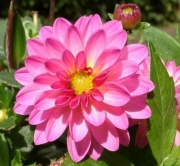Difference between revisions of "Dahlia"
Jump to navigation
Jump to search
(username removed) |
|||
| (2 intermediate revisions by 2 users not shown) | |||
| Line 2: | Line 2: | ||
== Description == | == Description == | ||
| − | A natural orange dye obtained from any dahlia flowers, stems, and leaves (Dahlia sp.). Single color dahlia flower petals produce a clearer, brighter tone, than when varying colors and leaves are mixed. On [ | + | A natural orange dye obtained from any dahlia flowers, stems, and leaves (Dahlia sp.). Single color dahlia flower petals produce a clearer, brighter tone, than when varying colors and leaves are mixed. On [[wool]] with a chrome mordant, yellow dahlia flower petals give a strong orange color that has fair lightfastness. Other colors from yellow to yellow-green (copper mordant) can also be obtained. Dahlia flowers do not dye [[cotton]] well and are not lightfast when mordanted with [[alum]]. The colorant from dahlia flowers is an acid-base indicator dye that has been used to color test papers. It turns red with acids and green with alkalis. |
| − | == | + | ==Resources and Citations== |
* R.J. Adrosko, ''Natural Dyes in the United States'', Smithsonian Institution Press, Washington, DC, 1968 | * R.J. Adrosko, ''Natural Dyes in the United States'', Smithsonian Institution Press, Washington, DC, 1968 | ||
| Line 10: | Line 10: | ||
* E.J.LaBarre, ''Dictionary and Encyclopedia of Paper and Paper-making'', Swets & Zeitlinger, Amsterdam, 1969 | * E.J.LaBarre, ''Dictionary and Encyclopedia of Paper and Paper-making'', Swets & Zeitlinger, Amsterdam, 1969 | ||
| − | * ''Encyclopedia Britannica'', http://www.britannica.com Comment: "Dahlia." | + | * ''Encyclopedia Britannica'', http://www.britannica.com Comment: "Dahlia." Accessed 13 Nov. 2004 . |
| − | * Wikipedia | + | * Wikipedia: http://en.wikipedia.org/wiki/Dahlia |
[[Category:Materials database]] | [[Category:Materials database]] | ||
Latest revision as of 15:09, 14 July 2022
Description
A natural orange dye obtained from any dahlia flowers, stems, and leaves (Dahlia sp.). Single color dahlia flower petals produce a clearer, brighter tone, than when varying colors and leaves are mixed. On Wool with a chrome mordant, yellow dahlia flower petals give a strong orange color that has fair lightfastness. Other colors from yellow to yellow-green (copper mordant) can also be obtained. Dahlia flowers do not dye Cotton well and are not lightfast when mordanted with Alum. The colorant from dahlia flowers is an acid-base indicator dye that has been used to color test papers. It turns red with acids and green with alkalis.
Resources and Citations
- R.J. Adrosko, Natural Dyes in the United States, Smithsonian Institution Press, Washington, DC, 1968
- E.J.LaBarre, Dictionary and Encyclopedia of Paper and Paper-making, Swets & Zeitlinger, Amsterdam, 1969
- Encyclopedia Britannica, http://www.britannica.com Comment: "Dahlia." Accessed 13 Nov. 2004 .
- Wikipedia: http://en.wikipedia.org/wiki/Dahlia
